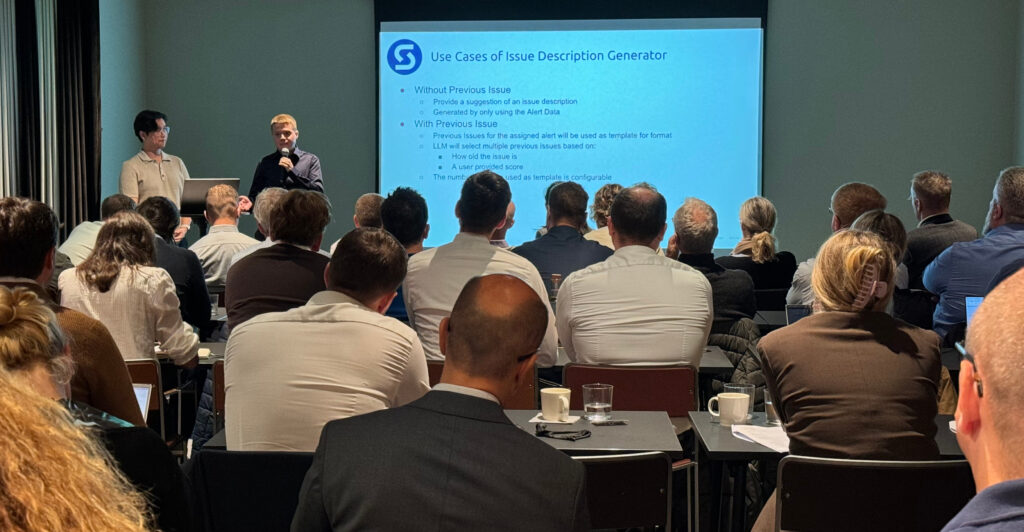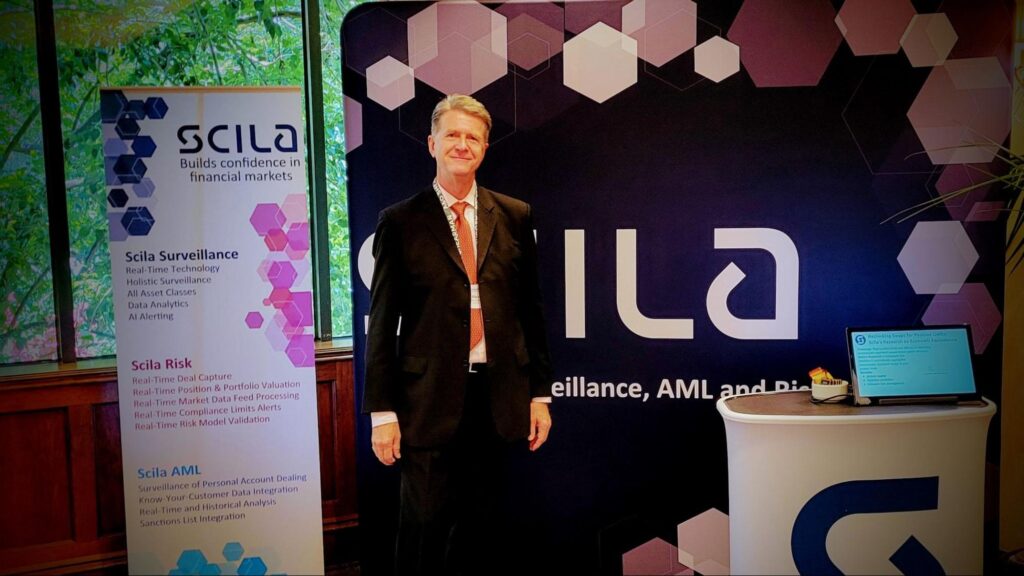We’re thrilled to report that the Scila User Group, held from September 17-19, 2024, was a resounding success! This year’s event brought together our global community of regulators, exchanges, market participants, and energy & commodity firms for three days of insightful presentations, valuable networking, and engaging discussions.
User-Driven Knowledge Sharing
A key highlight of the Scila User Group is its emphasis on user-generated content. Our customers took center stage, sharing their experiences, best practices, and innovative use cases of Scila solutions. This peer-to-peer learning approach fostered a collaborative environment and provided invaluable insights for all attendees.
Scila’s AI Roadmap Sparks Excitement
Scila also presented on several key topics, with the AI presentation proving particularly popular. Our AI experts showcased the latest AI functionalities within the Scila platform and unveiled our ambitious roadmap for future AI development, generating significant excitement and anticipation among our users.

Remit II in Focus for Energy and Commodities
The dedicated energy and commodity trading track delved into the challenges and opportunities presented by Remit II. Expert discussions and presentations explored how Scila help firms navigate the complexities of this crucial regulation and ensure ongoing compliance.
Valuable Feedback Fuels Future Innovation
The Scila User Group 2024 was a resounding success, with attendees expressing their appreciation for the event’s format, content, and networking opportunities. We are genuinely grateful for all the feedback and insightful discussions, which will play a crucial role in shaping the future development of our products. We remain committed to staying at the cutting edge of market surveillance technology and empowering our customers to succeed in today’s dynamic financial landscape.
We look forward to welcoming you to the next Scila User Group!
Introducing two new Scila features
Scila recently introduced two new features: an AI-assisted quality assurance workflow and near-miss analysis. Near misses are alerts that almost triggered but did not breach the defined thresholds. These two features, although seemingly unrelated, share the same goal: to provide qualitative detection and analysis of any misbehavior.
Near misses
Near misses in surveillance analysis are more detrimental than false positives because they go unnoticed. This is because, by definition, a near miss did not reach the defined threshold, so no alert is triggered. However, there is a risk that a near miss is actually a valid alert, suggesting that thresholds should be adjusted accordingly. False positives, on the other hand, are simply an inconvenience that generates additional work for analysts.
Traditionally, managing this issue involves setting thresholds wide enough to minimize the risk of missing a valid alert, even if it results in an excessive number of false positives. However, as previously stated, this approach necessitates substantial manual analysis effort to eliminate the false positives.
Scila’s new “Near Misses” feature provides an alternative approach. It enables users to create a mirrored set of the current alert rule set with broader parameters, resulting in more mirror alerts. However, only the delta compared to the regular alerts is considered as “near misses.” These near misses are handled separately and not integrated into the standard alert workflow or views of Scila. Consequently, they do not add any additional analytical work for users.
How are near-miss alerts utilized if they are hidden from the user?
These alerts are employed to generate aggregated statistics. These statistics can then be used to effectively identify new patterns. Examples of these patterns include an increase in the number of near misses for particular participants or instruments or the ratio between genuine alerts and near misses.
Once a suspected pattern is detected, the user can explicitly retrieve the alerts representing the relevant near misses. They can then review the parameters and potentially adjust the parameters of the real set of alert rules.
Although analyzing the aggregated near misses alerts statistics may require some effort from the user, it is likely to be significantly less work compared to manually sorting through individual false positives.
AI assisted quality workflow
Scila has a built-in quality assurance mechanism where a user can randomly select issues for review. This mechanism allows for a structured review with the necessary documentation.
However, the new feature focuses on improving the selection process of these issues. Although random selection is a theoretically sound method, it could be enhanced by choosing issues that exhibit uncommon characteristics. The challenge lies in defining these unique aspects.
As suggested by the feature’s name, the solution involves utilizing AI. Identifying such patterns is a strength of AI. Some examples of detectable issues include:
- Adding individual alerts that are unrelated to the issue being closed.
- Excessively complex and unusual textual explanations for closing an issue.
It’s important to note that the intention is not to replace the random selection process but to complement it with AI-based processes.
While this feature is simple and straightforward, it has the potential to become a powerful tool in ensuring the quality of issue and alert handling.
Lars-Ivar Sellberg, Executive Chairman Scila
Scila in the Americas
FIA Forum: Commodities 2024 in Houston Texas
At Scila’s second Commodities event in the US, Christopher Herron from Stockholm and Alex Lamb from the US office represented the company. They engaged with clients and potential partners, discussing topics such as surveillance, risk management, and position limits.

During the conference, regulatory themes such as position limits and artificial intelligence (AI) were addressed, with energy markets remaining the central theme. Renewables and carbon emerged as additional focal points, similar to the previous year. Many attendees represented their firms’ compliance teams, with some risk managers also present. Several participants expressed concerns that the separation of functions, systems, and disparate datasets hindered efficiency and effective controls.
In a panel discussion on risk management, experts emphasized the need for more timely and comprehensive insights into current risks and potential outliers, which continuous testing could reveal. They also highlighted the challenges posed by the diverse aspects of client, counterparty, CCP, and global risk profiles, particularly for larger organizations.
Meanwhile, a separate panel on surveillance touted AI as a potential solution. However, this notion was countered by arguments that better processes, data, and staff skills, combined with proven tools, should be leveraged to enhance overall productivity in risk assessments. Incorporating risk events or alerts into the surveillance mix would provide a deeper understanding of traders’ behaviors, increase the likelihood of identifying potential breaches early on, and ultimately save organizations money in the long run.
Scila will be at FIA Expo November 18th to the 20th – see you at our stand in Chicago!
In Europe – and maybe farther afield
MiCA – the Markets in Crypto-Assets Regulation in the EU started in June 2023, but some parts won’t be fully up and running until December 2024.

The EU’s MiCA regulation aims to protect consumers, maintain financial stability, and establish uniform rules for crypto-asset markets. It focuses on stablecoins, aiming to promote their use as an alternative means of payment. MiCA seeks to create a larger EU crypto-asset market, foster funding sources for businesses, and develop EU-based DLT infrastructure.
Primarily regulating stablecoins, asset-reference tokens, and e-money tokens, all firms, exchanges, brokers and crypto-asset service providers must adhere to communication, safeguarding, record-keeping, licensing, and other obligations. These will also include AML and sanctions monitoring as well as surveillance and risk management.
Challenges include ongoing US debate on classifying crypto-assets as securities (or not).
The fact that these regulations are on their way means that many firms doing business in the EU are building out their capabilities to comply with these rules. Various regulatory organisations outside Europe are watching this unfold, and there is a sense that other countries will follow suit, which will potentially be beneficial to the standing of the crypto markets and their facilitators.